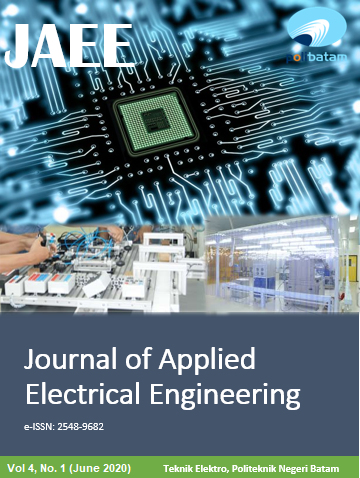Alat Monitoring Radiasi Matahari di Pulau Batam
DOI:
https://doi.org/10.30871/jaee.v4i1.1929Keywords:
Radiasi matahari, solar tracker, lookup table, modul real time clock, Perrin de BrichambautAbstract
Photovoltaics (PV) cell adalah sebuah elemen yang dapat melakukan konversi energi dari radiasi akibat panas matahari menjadi energi listrik dengan prinsip semikonduktor. Tegangan dan arus listrik yang dihasilkan sel surya dipengaruhi oleh tingkat intensitas radiasi cahaya matahari dan temperatur udara lingkungan. Alat yang dibuat dalam penelitian ini didesain dengan menggunakan metode lookup table yang dibuat dengan memakai 2 motor sebagai penggerak sumbu x dan y dalam menentukan koordinat dari posisi matahari yang digunakan sebagai penentu intensitas radiasi matahari di Pulau Batam. Perangkat ini juga terintegrasi dengan waktu menggunakan real time clock module.
Downloads
References
"Solar Energy Perspectives "“ Analysis - IEA." [Online]. Available: https://www.iea.org/reports/solar-energy-perspectives. [Accessed: 26-Feb-2020].
I. B. K. S. Negara, I. W. A. Wijaya, and A. A. G. M. Pemayun, "Analisis Perbandingan Output Daya Listrik Panel Surya Sistem Tracking dengan Solar Reflector," J. Ilm. Spektrum, vol. 3, no. 1, pp. 7"“13, 2016.
K. Akhmad, "Pembangkit Listrik Tenaga Surya Dan Penerapannya Untuk Daerah Terpencil," J. Ilm. Din. Rekayasa, vol. 1, no. 1, pp. 29"“33, 2005.
B. Yuliarto, Memanen Energi Matahari. Bandung: Penerbit ITB, 2017.
"Profil Kota Batam." [Online]. Available: http://ciptakarya.pu.go.id/profil/profil/barat/kep_riau/batam.pdf.
T. Juhana and A. I. Irawan, "Non-intrusive load monitoring using Bluetooth Low Energy," in Proceeding of the 2015 9th International Conference on Telecommunication Systems Services and Applications, TSSA 2015, 2016.
M. Ghodbane and B. Boumeddane, "Estimating solar radiation according to semi empirical approach of PERRIN DE BRICHAMBAUT: application on several areas with different climate in Algeria," Int. J. Energ., vol. 1, no. 1, pp. 20"“29, 2016.
S. A. Kalogirou, Solar Energy Engineering: Processes and Systems, 1st ed. Academic Press, 2009.
A. Rabl, Active Solar Collectors and Their Applications. Oxford: Oxford University Press, 1985.
Z. Åžen, Solar energy fundamentals and modeling techniques: Atmosphere, environment, climate change and renewable energy. 2008.
D. Y. Goswami, F. Kreith, and F. Kreith, "Solar Energy Resources," pp. 81"“90, Jul. 2007.
M. Lehloka, J. Swart, and P. Hertzog, "A comparison of two automatic solar tracking algorithms," E3S Web Conf., vol. 152, p. 02009, 2020.
Downloads
Published
How to Cite
Issue
Section
License
Authors who publish with this journal agree to the following terms:
- Authors retain copyright and grant the journal right of first publication with the work simultaneously licensed under a Creative Commons Attribution License (Attribution-ShareAlike 4.0 International (CC BY-SA 4.0) ) that allows others to share the work with an acknowledgment of the work's authorship and initial publication in this journal.
- Authors are able to enter into separate, additional contractual arrangements for the non-exclusive distribution of the journal's published version of the work (e.g., post it to an institutional repository or publish it in a book), with an acknowledgment of its initial publication in this journal.
- Authors are permitted and encouraged to post their work online (e.g., in institutional repositories or on their website) prior to and during the submission process, as it can lead to productive exchanges, as well as earlier and greater citation of published work (See The Effect of Open Access).
Open Access Policy
This journal provides immediate open access to its content on the principle that making research freely available to the public supports a greater global exchange of knowledge. Its free availability on the public internet, permitting any users to read, download, copy, distribute, print, search, or link to the full texts of these articles, crawl them for indexing, pass them as data to software, or use them for any other lawful purpose, without financial, legal, or technical barriers other than those inseparable from gaining access to the internet itself.















